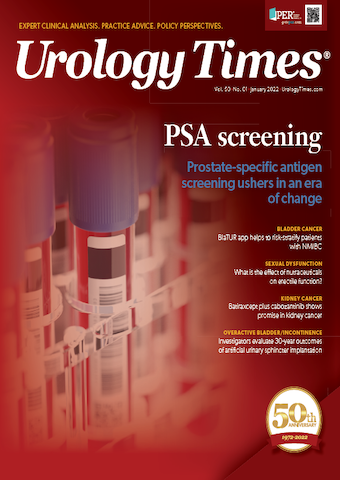Publication
Article
Urology Times Journal
Prostate-specific antigen–based screening ushers in an era of change
Author(s):
William J. Catalona, MD, explains how prostate-specific antigen (PSA) testing revolutionized screening and treatment of prostate cancer.
Urology Times® is celebrating its 50th anniversary in 2022. To mark the occasion, we are highlighting 50 of the top innovations and developments that have transformed the field of urology over the past 50 years. We will be featuring a different innovation each week on our website, www.urologytimes.com, along with selected highlights in each monthly issue of the magazine. This month, William J. Catalona, MD, explains how prostate-specific antigen (PSA) testing revolutionized screening and treatment of prostate cancer. Catalona is a professor of urology at Northwestern University Feinberg School of Medicine in Chicago, Illinois.
How did PSA testing revolutionize how prostate cancer is detected and diagnosed?
From the 1930s to the 1990s, the prostate cancer death rate in the United States increased steadily, as fewer and fewer men died of cardiovascular causes and more men lived long enough to become victims of prostate cancer. Up until the late 1980s, the only way [to diagnose] prostate cancer early was via a digital rectal examination (DRE) of the prostate. Men were reluctant to undergo these examinations, so [many] of the prostate cancer cases were advanced and incurable at the time of diagnosis.
The PSA blood test was first approved by the FDA as a test to aid the management of patients diagnosed with prostate cancer, but it was not believed to be useful as a first-line tool for early detection, largely because of false-positive and false-negative results.
In 1968, the National Cancer Institute (NCI) held a meeting in Prouts Neck, Maine, with the goal of improving the early detection of prostate cancer by the year 2000, which seemed long into the future [at that time]. The 3 candidate methods discussed were the then accepted DREs, the then newly introduced prostate transrectal ultrasound scan, and the PSA blood test. I had been collecting data from my patients with each of these methods for several years before the meeting. During the meeting, [in my head], I calculated rough estimates of the sensitivity, specificity, and positive and negative predictive value of each. It became apparent to me that the PSA test was the best of the 3 by far. When I stated this to the attendees, I was howled down because, as the attendees agreed, “We all know PSA cannot be a screening test because it can be elevated in men who have benign enlargement of the prostate and in those who have inflammation of the prostate.” They were looking for something like a pregnancy test that, when it was positive, there would always be cancer, and when it was negative, there never would be cancer. However, considering the statistics, it became apparent to me that using certain cutoffs, PSA testing could improve early detection over DRE.
After that meeting, I approached Hybritech, Inc, [which] then owned the patent for the best PSA test available at that time, and [I] told them I believed PSA could be used as a first-line screening test for prostate cancer. I requested funding for a screening study to test this hypothesis. They invited me to San Diego, but when I arrived, I found them unconvinced. I presented my data to their lawyers, their marketing group, and their scientists. They remained skeptical but finally agreed to provide funds for me to run a study of [approximately] 1000 patients using PSA as a screening test.
The early results were promising, and after the first 1600 patients, my research group published a paper in the New England Journal of Medicine (NEJM) in April 1991, showing that the PSA test used as a first-line [screening test] provided a better method of detecting prostate cancer than the gold-standard DRE. 1 The fact that it was a simple blood test and was objective and noninvasive, except for having the blood drawn, made it very attractive. The NEJM enjoys great credibility, so my paper received widespread media publicity in the New York Times, Time magazine, network television, etc. I believe this study launched the PSA screening era, as PSA screening was more or less widely adopted throughout the US and later throughout the world. There followed soon afterward, the launching of 2 large prospective, randomized clinical trials of PSA screening in the US—called the Prostate, Lung, Colorectal and Ovarian Cancer Screening Trial, or PLCO [NCT00002540]—and Europe—called the European Randomized study of Screening for Prostate Cancer, or ERSPC—to quantify the long-term benefits for patients.
To gain FDA approval for PSA as an early detection test, I led a large multi-institutional study that achieved FDA approval in 1994. Subsequently, I led similar large-scale studies of the free PSA test (FDA approved in 2007), and the Prostate Health Index test (FDA approved in 2012) as improvements on the accuracy of the PSA test for early detection.
The early results of ERSPC and the erroneous, disparate results of PLCO were published in tandem in the NEJM in 2009. ERSPC reported that after 13 years of follow-up, the prostate cancer death rate was 21% lower among men in the screening arm, whereas the PLCO trial reported there was no benefit in the screening arm. However, the PLCO trial did not accurately report that nearly 90% of the men in their control [nonscreening] trial arm had at least 1 PSA test during the trial. This contamination of PLCO was not widely appreciated until other [investigators] reported this flaw in the trial in the NEJM. Later, the NCI’s statistical task force reanalyzed the PLCO data and found a 27% to 32% lower prostate cancer mortality risk in the screening arm.
The US Preventive Services Task Force (USPSTF) weighted heavily the early negative PLCO trial, and in 2010, they issued a grade D recommendation against PSA screening for men over age 70, followed [by] a grade D recommendation against screening for all men, all ages, and all risk groups [in 2012]. Up until the [USPSTF’s] recommendation, the prostate cancer death rate had decreased by more than 50% from the beginning of my 1991 NEJM publication until 2010.
The use of PSA as a screening tool has been said to result in overdetection and overtreatment of prostate cancer. What is your opinion on this?
I think it’s true. Before the PSA test came along, we almost always diagnosed prostate cancer when it was too late. Through PSA testing, we can discover life-threatening tumors in time to cure them, but we also detect possible harmless cancers in some patients whose PSA was elevated because of other benign conditions. In those times, most men underwent treatment, and some had unnecessary [adverse] effects that reduced their quality of life. Of course, this was a big concern, even though PSA screening reduced the prostate cancer death rate by more than half.
How did the USPSTF’s recommendations regarding PSA-based prostate cancer screening affect its use and public perception?
It had a very profound effect. It greatly decreased PSA screenings, biopsies, and curative interventions for prostate cancer. Perhaps worse, it misinformed a generation of family practitioners and internists that PSA testing was a bad thing that should not be done.
The task force was throwing away the baby with the bathwater. The NCI’s statistical task force predicted that if the task force’s recommendation were followed, by the year 2025, we would lose all the gains in early prostate cancer detection that we had made up to that time, and their models proved true. We began to see in the national statistics that the number of advanced cases increased, especially those with metastatic disease at diagnosis, and the number of early cases decreased. The prostate cancer death rate that had been decreasing steadily began to take a turn back up. In 2018, perhaps pressured upon this emerging worrisome data and the good news about an increasing adoption of active surveillance for patients with low-risk disease, the [USPSTF] revised its screening recommendation that clinicians could inform men aged 55 [to] 69 about the potential benefits and harms of screening, but it continued to recommend against screening for men 70 [years] or more. They made no special recommendation for high-risk populations, such as men with a strong family history of prostate cancer or Black men.
Nevertheless, even today, we frequently encounter patients who had undergone PSA testing up until the [USPSTF’s] negative recommendation, then stopped testing. Now, after resuming testing, they are diagnosed with advanced, incurable prostate cancer. So the [USPSTF’s] ban continues to haunt us. It is encouraging that a 2020 NEJM study reported that evidence from the randomized trials shows that PSA screening prevents metastatic disease and reduces prostate cancer mortality and, with long-term follow-up, suggests that the balance of benefits and harms of screening is more favorable than generally appreciated.
As further prostate cancer tests and biomarkers are developed and refined, what would you say is PSA’s legacy in the history of prostate cancer detection and diagnosis?
I believe the PSA test is the best early cancer detection in all of medicine. It’s not perfect, but it’s better than anything out there, because it is a simple blood test and very objective. It would be great if we had a PSA-like test for breast, lung, colorectal, and pancreatic cancer. There will be other biomarkers that will add to PSA testing in the future, such as blood, saliva, urine, and tissue-based tests, and new and better imaging tests that can be added into an algorithm that will help us identify men who have prostate cancer and stratify their risk. But, at least for the foreseeable future, PSA is going to be the mainstay for early prostate cancer detection.
Click to watch a video of Dr. Catalona discussing the PSA testing revolution.
Reference
1. Catalona WJ, Smith DS, Ratliff TL, et al. Measurement of prostate-specific antigen in serum as a screening test for prostate cancer. N Engl J Med. 1991;324(17):1156-1161. doi:10.1056/NEJM199104253241702

































